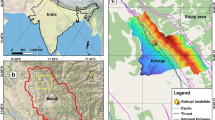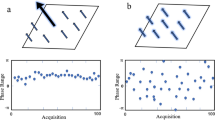Abstract
Lots of accumulation landslides with step-like displacements occurred in the Three Gorges Reservoir due to periodic reservoir operation. This type of landslide has continued to deform for a long time, with large cumulative deformation, which may influence the land use in the reservoir and landslide control risk judgment. The accumulation landslides with four typical step-like displacement-time curves during more than 10 years, namely Baijiabao landslide, Laoshewo landslide, Heishiban landslide, and Shuping landslide, are demonstrated. The cumulative displacement-time curve of Laoshewo landslide obviously shows that its deforming tendency is slowing down, while that of Heishiban landslide clearly indicates the increasingly serious deformation. When the step-like displacement increments get close to each other, it is harder to predict the landslide tendency based on displacement, velocity, inverse velocity, or acceleration in a whole continuous period. A step-like displacement-time curve can be considered as a curve of a piecewise function, varying as time goes. Therefore, the piecewise function is proposed to analyze the tendency by different time periods. As the environment of rapid deforming period is similar, the deforming tendency of a landslide with step-like displacements can be better demonstrated by collecting data in the rapid deforming period to analyze its tendency. For Shuping landslide, the fluctuating decline in velocity and acceleration in the rapid deforming period shows that the landslide tends to become more and more stable. This well matches the status quo of Shuping landslide, as it has been treated during August 2014 to March 2015, which also verifies the effectiveness of this proposed method. For Baijiabao landslide, the inverse velocity-time curve in the rapid deforming period features fluctuating decline, indicating that the landslide tends to be increasingly unstable. Meanwhile, the discussion on failure prediction found that the watch window for critical prediction of Baijiabao landslide may open in the flood season of several years’ future. The method proposed is effective for predicting the deforming tendency of landslides with step-like displacements, provides a time window for critical prediction, and offers technical support for landslide risk control, alarm, and forecasting.














Similar content being viewed by others
References
Belle P, Aunay B, Bernardie S, Grandjean G, Ladouche B, Mazue R, Join J-L (2014) The application of an innovative inverse model for understanding and predicting landslide movements (Salazie cirque landslides, Reunion Island). Landslides 11(3):343–355
Calvello M, Cascini L, Sorbino G (2008) A numerical procedure for predicting rainfall-induced movements of active landslides along pre-existing slip surfaces. Int J Numer Anal Methods Geomech 32(4):327–351
Calvello M, Silvestri Francesco, Andreotti D (2013) Inverse analysis of an active landslide along the banks of a reservoir. C. Margottini et al. (eds.), Landslide Sci Pract, 6: 65–72
Cao Y, Yin K, Alexander David E, Zhou C (2016) Using an extreme learning machine to predict the displacement of step-like landslides in relation to controlling factors. Landslides 13(4):725–736
Cascini L, Calvello M, Grimaldi G (2010) Groundwater modeling for the analysis of active slow-moving landslides. J Geotech Geoenviron 136(9):1220–1230
Chen L, Zhigang Z, Wei Y, Huiming T (2013) Displacement prediction model of landslide based on a modified ensemble empirical mode decomposition and extreme learning machine. Nat Hazards 66:759–771
China Three Gorges Uninversity (2016) Annual report of geological hazard monitoring and warning project in Zigui County in Three Gorges Reservoir. China Three Gorges University, Yichang
Corominas J, Moya J, Ledesma A, Lioret A, Gili JA (2005) Prediction of ground displacements and velocities from groundwater level changes at the Vallcebre landslide (Eastern Pyrenees, Spain). Landslides 2(2):83–96
Corsini A, Mulas M (2016) Use of ROC curves for early warning of landslide displacement rates in response to precipitation (Piagneto landslide, Northern Apennines, Italy). Landslides 14:1241–1252. https://doi.org/10.1007/s10346-016-0781-8
Di Traglia F, Nolesini T, Intrieri E, Mugnai F, Leva D, Rosi M, Casagli N (2014) Review of ten years of volcano deformations recorded by the ground-based InSAR monitoring system at Stromboli volcano: a tool to mitigate volcano flank dynamics and intense volcanic activity. Earth-Sci Rev 139:317–335
Federico A, Popescu M, Elia G, Fidelibus C, Internò G, Murianni A (2012) Prediction of time to slope failure: a general framework. Environ Earth Sci 66:245–256
Fukuzono T (1985) A new method for predicting the failure time of slopes. Proceedings, 4th International Conference & Field Workshop on landslides, Tokyo, pp 145–150
Gigli G, Fanti R, Canuti P, Casagli N (2011) Integration of advanced monitoring and numerical modeling techniques for the complete risk scenario analysis of rockslides: the case of Mt. Beni (Florence, Italy). Eng Geol 120(1–4):48–59
He K, Wang S (2006) Double-parameter threshold and its formation mechanism of the colluvial landslide: Xintan landslide, China. Environ Geol 49:696–707
Helmstetter A, Sornette D, Grasso JR, Andersen JV, Gluzman S (2003) Slider-block friction model for landslides: application to Vaiont and Laclapière landslides. Physics 109(2):105–122
Hu X, Zhang M, Sun M et al (2015) Deformation characteristics and failure mode of the Zhujiadian landslide in the Three Gorges Reservoir, China. Bull Eng Geol Environ, online publication 74(1):1–12
Huang B, Chen X (2007) Deformation failure mechanism of Baijiabao landslide in Xiangxi River valley. Chin J Geotech Eng, 29(6) 938–942 (in Chinese)
Huang F et al (2016) Landslide displacement prediction using discrete wavelet transform and extreme learning machine based on chaos theory. Environ Earth Sci 75:1376–1393
Lane KS (1967) Stability of reservoir slopes, in: Failure and breakage of rock. In: Fairhurst C (ed) Proceedings of the Eighth Symposium on Rock Mechanics, Sept. 15-17, 1966, vol 321-3. University of Minnesota, Minneapolis, Minnesota, p 36
Leroueil S (2001) Natural slopes and cuts: movement and failure mechanism. Geotechnique 51(3):195–244
Li X, Kong J, Wang Z (2012) Landslide displacement prediction based on combining method with optimal weight. Nat Hazards 61(2):635–646
Lian C, Zeng Z, Yao W, Tang H (2013) Displacement prediction model of landslide based on a modified ensemble empirical mode decomposition and extreme learning machine. Nature Hazards 66(2):759–771
Liu Z, Shao J, Xu W, et al (2014) Comparison on landslide nonlinear displacement analysis and prediction with computational intelligence approaches. Landslides 11(5): 889–896
Miao S, Hao X, Guo X, Wang Z, Liang M (2017) Displacement and landslide forecast based on an improved version of Saito’s method together with the Verhulst-Grey model. Arab J Geosci 10(3):53–62
Müller L (1964) The rock slide in the Vaiont Valley. Felsmechanik u. Ingenieurgeologie 4(2):148–212
Paronuzzi P, Bolla A, Rigo E (2016) Brittle and ductile behavior in deep-seated landslides: learning from the vajont experience. Rock Mech Rock Eng 49(6):2389–2411
Qin SQ, Jiao JJ, Wang SJ (2001) The predictable time scale of landslides. Bull Eng Geol Environ 59:307–312
Saito M (1969) Research on forecasting the time of occurrence of slope failure. Soil Mech Found Eng 17:29–38
Sornette D, Helmsteller A, Andersen JV, Gluzman S, Grasso JR, Pisarenko V (2004) Towards landslide predictions: two case studies. Physica A 338:605–632
Tommaso C, Intrieri E, Di Traglia F, Nolesini T, Gigli G, Casagli N (2016) Guidelines on the use of inverse velocity method as a tool for setting alarm thresholds and forecasting landslides and structure collapses. Landslides. https://doi.org/10.1007/s10346-016-0731-511212
Voight B (1988) Materials science law applies to time forecasts of slope failure, vol 3. Proceedings of the Vth International Symposium on Landslides, Lausanne, pp 1471–1472
Vulliet L, Hutter K (1988) Viscous-type sliding laws for landslides. Can Geotech J 25(3):467–477
Wang S, Ma F, Yonglian D (1996) On the rock-water interaction in reservoir areas and its geoenvironmental effect. J Eng Geol 4(3):1–9
Wu X, Zhan FB, Zhang K, Deng Q (2016) Application of a two-step cluster analysis and the Apriori algorithm to classify the deformation states of two typical colluvial landslides in the Three Gorges, China. Environ Earth Sci 75(2):146–161
Xing Linxiao (2012) The mechanism and forecasting study on typical accumulation landslide of Three Gorges Reservoir. Dissert for postgraduate, China University of Geosciences (Wuhan)
Xu Q, Zeng Y (2009) Research on acceleration variation characteristics of creep landslide and early-warning prediction indicator of critical sliding. Chin J Rock Mech Eng 28(6):1099–1106
Yin Y, Bolin H, Wang W, Yunjie W, Ma X, Ma F, Changjun Z (2016) Reservoir-induced landslides and risk control in Three Gorges Project on Yangtze River, China. J Rock Mech Geotech Eng 8:577–595
Zhang M, McSaveney M (2018) Is air pollution causing landslides in China? Earth Planet Sci Lett 481:284–289
Zhang M, Yin Y, Huang B (2015) Mechanisms of rainfall-induced landslides in gently inclined red beds in the eastern Sichuan. Landslides 12(5):973–983
Acknowledgments
This work was supported by the National Key R&D Program of China (ID: 2018YFC1504803), project from China Geological Survey (DD20190637), and Geological Hazard Prevention and Control Project for Follow-Up Work of the Three Gorges Project (000121 2018C C60 003, 000121 2018C C60 008). The authors thank Prof. Zhang Guodong from China Three Gorges University, who provided the authors with a good platform to innovate and exploit.
Author information
Authors and Affiliations
Corresponding author
Additional information
Responsible Editor: Zeynal Abiddin Erguler
Rights and permissions
About this article
Cite this article
Lu, S., Huang, B. Deforming tendency prediction study on typical accumulation landslide with step-like displacements in the Three Gorges Reservoir, China. Arab J Geosci 13, 329 (2020). https://doi.org/10.1007/s12517-020-05306-w
Received:
Accepted:
Published:
DOI: https://doi.org/10.1007/s12517-020-05306-w




